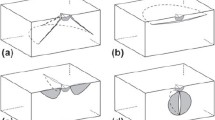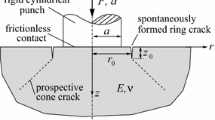Abstract
In a recent contribution, Kumar et al. (J Mech Phys Solids 142:104027, 2020) have introduced a comprehensive macroscopic phase-field theory for the nucleation and propagation of fracture in linear elastic brittle materials under arbitrary quasistatic loading conditions. The theory can be viewed as a natural generalization of the phase-field approximation of the variational theory of brittle fracture of Francfort and Marigo (J Mech Phys Solids 46:1319–1342, 1998) to account for the material strength at large. This is accomplished by the addition of an external driving force—which physically represents the macroscopic manifestation of the presence of inherent microscopic defects in the material—in the equation governing the evolution of the phase field. The main purpose of this paper is to continue providing validation results for the theory by confronting its predictions with direct measurements from three representative types of experimentally common yet technically challenging problems: (i) the indentation of glass plates with flat-ended cylindrical indenters and the three-point bending of (ii) U-notched and (iii) V-notched PMMA beams.













Similar content being viewed by others
Notes
By strength we refer to the general definition of strength introduced by Kumar et al. (2020), which we recall here for the reader’s convenience. When any piece of the elastic brittle material of interest is subjected to a state of monotonically increasing uniform but otherwise arbitrary stress, fracture will nucleate from one or more of its inherent defects at a critical value of the applied stress. The set of all such critical stresses defines a surface in stress space. In terms of the Cauchy stress tensor \(\varvec{\sigma }\), we write \({\mathcal {F}}(\varvec{\sigma })=0\). This definition generalizes the various notions of ‘tensile’ and ‘shear’ strength that were proposed on the heels of the introduction of the stress tensor (Cauchy 1823)by numerous pioneers of continuum mechanics including Lamé, Clapeyron, Tresca, and Mohr; see, e.g., the historical account on rupture of solids in the classic monograph by Love (Love 1906; Section 83). We also note that it has long been recognized that a Griffith criterion alone cannot predict nucleation in general. Attempts to model nucleation of fracture near a notch front in terms of a “tensile” strength at a critical distance from the front combined with a critical energy release rate can be found, for instance, in (Leguillon 2002).
“Large” refers to large relative to the characteristic size of the underlying heterogeneities in the material under investigation. By the same token, “small” refers to sizes that are of the same order or just moderately larger than the sizes of the heterogeneities.
References
Aranda-Ruiz J, Ravi-Chandar K, Loya JA (2020) On the double transition in the failure mode of polycarbonate. Mech Mater 140:103242
Bourdin B, Francfort GA, Marigo JJ (2000) Numerical experiments in revisited brittle fracture. J Mech Phys Solids 48:797–826
Bower AF, Ortiz M (1991) A three-dimensional analysis of crack trapping and bridging by tough particles. J Mech Phys Solids 39:815–858
Bresler B, Pister KS (1958) Strength of concrete under combined stresses. ACI J Proc 55:321–345
Cauchy AL (1823) Recherches sur l’équilibre et le mouvement intérieur des corps solides ou fluides, élastiques ou non élastiques. [Researche on the equilibrium and internal motion of solid or fluid bodies, elastic or not elastic] Bulletin de la Société Philomatique, pp 300–304
Christensen RM, Freeman DC, DeTeresa SJ (2002) Failure criteria for isotropic materials, applications to low-density types. Int J Solids Str 39:973–982
Cox B, Yang Q (2006) In quest of virtual tests for structural composites. Science 314:1102–1107
Drucker DC, Prager W (1952) Soil mechanics and plastic analysis for limit design. Q Appl Math 10:157–165
Drugan WJ, Willis JR (1996) A micromechanics-based nonlocal constitutive equation and estimates of representative volume element size for elastic composites. J Mech Phys Solids 44:497–524
Dunn ML, Suwito W, Cunningham S (1997) Fracture initiation at sharp notches: correlation using critical stress intensities. Int J Solids Struct 34:3873–3883
Fischer-Cripps A (2007) Introduction to contact mechanics. Springer, New York
Francfort GA, Marigo JJ (1998) Revisiting brittle fracture as an energy minimization problem. J Mech Phys Solids 46:1319–1342
Francfort GA, Giacomini A, Lopez-Pamies O (2019) Fracture with healing: a first step towards a new view of cavitation. Anal PDE 12:417–447
Gao H, Rice JR (1989) A first-order perturbation analysis of crack trapping by arrays of obstacles. J Appl Mech 56:828–836
Gómez FJ, Elices M, Planas J (2005) The cohesive crack concept: applications to PMMA at \(-60\)\(^{\circ }\)C. Eng. Frac. Mech. 72:1268–1285
Griffith AA (1921) The phenomena of rupture and flow in solids. Philos Trans R Soc Lond A 221:163–198
Guin JP, Gueguen Y (2019) Mechanical properties of glass. In: Musgraves JD, Hu J, Calvez L (eds) Springer handbook of glass. Springer, Berlin
Hertz H (1882) On the contact of rigid elastic solids and on hardness. Verh. Ver. Beförderung Gewerbefleisses 61:410–430
Hossain MZ, Bourdin B, Bhattacharya K, Hsueh C-J (2014) Effective toughness of heterogeneous media. J Mech Phys Solids 71:320–348
Hsueh C-J, Bhattacharya K (2016) Homogenization and path independence of the J-integral in heterogeneous materials. J Appl Mech 83:101012
Kumar A, Francfort GA, Lopez-Pamies O (2018) Fracture and healing of elastomers: a phase-transition theory and numerical implementation. J Mech Phys Solids 112:523–551
Kumar A, Ravi-Chandar K, Lopez-Pamies O (2018) The configurational-forces view of fracture and healing in elastomers as a phase transition. Int J Fract 213:1–16
Kumar A, Lopez-Pamies O (2020) The phase-field approach to self-healable fracture of elastomers: a model accounting for fracture nucleation at large, with application to a class of conspicuous experiments. Theoret Appl Fract Mech 107:102550
Kumar A, Bourdin B, Francfort GA, Lopez-Pamies O (2020) Revisiting nucleation in the phase-field approach to brittle fracture. J Mech Phys Solids 142:104027
Kumar A, Lopez-Pamies O (2021) The poker-chip experiments of Gent and Lindley (1959) explained. J Mech Phys Solids 150:104359
Lawn BR (1998) Indentation of ceramics with spheres: a century after Hertz. J Am Ceram Soc 81:1977–1994
Leguillon D (2002) Strength or toughness? a criterion for crack onset at a notch. Euro J Mech A/Solids 21:61–72
Love AEH (1906) A treatise on the mathematical theory of elasticity. Cambridge University Press, Cambridge
Michel JC, Suquet P (2022) Merits and limits of a variational definition of the effective toughness of heterogeneous materials. J Mech Phys Solids 164:104889
Mouginot R, Maugis D (1985) Fracture indentation beneath flat and spherical punches. J. Mater. Sci. 20:4354–4376
Munz D, Fett T (1999) Ceramics: mechanical properties, failure behaviour, materials selection. Springer, New York
Rankine WJM (1857) On the stability of loose earth. Philos Trans R Soc Lond 147:9–27
Schneider M (2020) An FFT-based method for computing weighted minimal surfaces in microstructures with applications to the computational homogenization of brittle fracture. Int J Numeri Methods Eng 121:1367–1387
Strobl M, Seelig T (2020) Phase field modeling of Hertzian indentation fracture. J Mech Phys Solids 143:104026
Willam KJ, Warnke EP (1975) Constitutive models for the triaxial behavior of concrete. Proc Int Assoc Bridge Struct Eng 19:1–30
Zehnder AT (2012) Fracture mechanics. Springer, New York
Acknowledgements
Support for this work by the National Science Foundation through the grant CMMI–2132528 and the collaborative Grants CMMI–1901583 and CMMI–1900191 is gratefully acknowledged.
Author information
Authors and Affiliations
Corresponding author
Additional information
Publisher's Note
Springer Nature remains neutral with regard to jurisdictional claims in published maps and institutional affiliations.
Appendix: sample results showcasing the independence of the phase-field theory (4)–(5) on the localization length \(\varepsilon \)
Appendix: sample results showcasing the independence of the phase-field theory (4)–(5) on the localization length \(\varepsilon \)
In this appendix, as a complement to the results reported in Section 4.3 in (Kumar et al. 2020), we report sample results for each of the three classes of boundary-value problems investigated in the main body of the text that showcase the independence of the phase-field theory (4)–(5) on the localization length \(\varepsilon \).
Contour plot of the phase field v predicted by the phase-field theory (4)–(5) for one of the indentation experiments of Mouginot and Maugis (1985). Part a reproduces the result in Fig. 4a for localization length (13), while part b shows the corresponding result for the different localization length (20)
Figure 14 provides a comparison between the result presented in Fig. 4a for the phase field v predicted by the theory for localization length (13) and that obtained for the different localization length
The calibration of the coefficient \(\delta ^\varepsilon \) for the values (20) renders \(\delta ^\varepsilon =60\) and \(\delta ^\varepsilon =6\), respectively, which result in an actual regularized size of the cracks given by \(\varepsilon ^\star =\varepsilon /\sqrt{1+\delta ^\varepsilon }=1.9\) \(\mu \)m. This is about three times smaller than the size of the cracks obtained for the localization length (13). Yet, it is evident that the results in Figs. 14a and b are essentially the same.
Next, Fig. 15 presents a comparison between the critical force \(P_{cr}\) in Fig. 9 predicted by the theory for notch depth \(A=5\) mm when using a localization length \(\varepsilon =12.5\) \(\mu \)m (solid line) and the corresponding result (dashed line) when using the smaller localization length \(\varepsilon =5\) \(\mu \)m. In the latter case, the calibrated value of the coefficient \(\delta ^\varepsilon \) turns out to be \(\delta ^\varepsilon =1.15\), which results in a regularized crack size of \(\varepsilon ^\star =\varepsilon /\sqrt{1+\delta ^\varepsilon }=3.4\) \(\mu \)m. This is about two times smaller than the regularized crack size that ensues from \(\varepsilon =12.5\) \(\mu \)m. Clearly, the results in Fig. 15 for the two different localization lengths are largely similar to one another.
Critical force \(P_{cr}\) predicted by the phase-field theory (4)–(5) for one of the U-notched beam experiments of Gómez et al. (2005). The solid line reproduces the result for notch depth \(A=5\) mm in Fig. 9 for localization length \(\varepsilon =12.5\) \(\mu \)m, while the dashed line corresponds to the result for localization length \(\varepsilon =5\) \(\mu \)m
Critical force \(P_{cr}\) predicted by the phase-field theory (4)–(5) for one of the V-notched beam experiments of Dunn et al. (1997). The solid line reproduces the result for notch angle \(\gamma =90^{\circ }\) in Fig. 13b for localization length \(\varepsilon =12.5\) \(\mu \)m, while the dashed line corresponds to the result for localization length \(\varepsilon =9\) \(\mu \)m
Finally, Fig. 16 presents a comparison between the critical force \(P_{cr}\) in Fig. 13b predicted by the theory for notch angle \(\gamma =90^{\circ }\) when using a localization length \(\varepsilon =12.5\) \(\mu \)m (solid line) and the corresponding result (dashed line) when using the smaller localization length \(\varepsilon =9\) \(\mu \)m. The calibrated value of the coefficient \(\delta ^\varepsilon \) for the latter case is \(\delta ^\varepsilon =35\), which results in a regularized crack size \(\varepsilon ^\star =\varepsilon /\sqrt{1+\delta ^\varepsilon }=1.5\) \(\mu \)m that is about six times smaller than the regularized crack size that is obtained for \(\varepsilon =12.5\) \(\mu \)m. Consistent with the two preceding comparisons, a quick glance at Fig. 16 suffices to recognize that the two theoretical predictions based on different localization lengths are practically the same.
Rights and permissions
About this article
Cite this article
Kumar, A., Ravi-Chandar, K. & Lopez-Pamies, O. The revisited phase-field approach to brittle fracture: application to indentation and notch problems. Int J Fract 237, 83–100 (2022). https://doi.org/10.1007/s10704-022-00653-z
Received:
Accepted:
Published:
Issue Date:
DOI: https://doi.org/10.1007/s10704-022-00653-z







